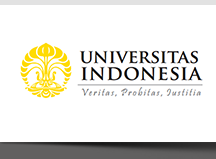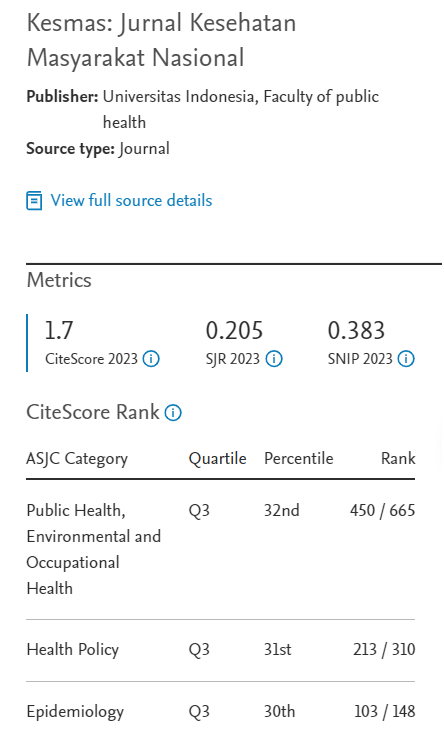Abstract
Asupan nutrisi dan energi, status nutrisi, serta aktivitas harian berpengaruh pada kejadian mengantuk yang berpengaruh negatif pada konsentrasi dan produktivitas belajar pada mahasiswa. Kejadian mengantuk berhubungan dengan penurunan kemampuan kognitif yang disebabkan oleh defisiensi zat besi. Seseorang yang mengantuk akan mengalami penurunan aktivitas fisik yang menyebabkan kelebihan berat badan sehingga berisiko lebih tinggi untuk terkena penyakit degeneratif seperti penyakit kardiovaskular dan diabetes melitus. Penelitian ini bertujuan untuk menganalisis faktor dominan yang berpengaruh pada kejadian mengantuk di kalangan mahasiswa. Penelitian dengan desain studi cross sectional ini dilakukan terhadap sampel 139 mahasiswa Fakultas Kesehatan Masyarakat Universitas Indonesia. Proporsi mahasiswa yang hampir mengantuk sekitar 28,80%. Terdapat hubungan yang signifikan antara durasi tidur dan masalah kantuk (nilai p = 0,048). Mahasiswa dengan durasi tidur < 8 jam per hari mengalami kejadian mengantuk 0,50 kali lebih besar daripada mahasiswa dengan durasi tidur > 8 jam per hari. Faktor dominan yang berhubungan dengan kejadian mengantuk adalah durasi tidur setelah dikontrol dengan asupan protein dan lemak, aktivitas fisik, dan paparan media. Mahasiswa yang sering mengantuk memperlihatkan asupan zat besi rendah sehingga disarankan untuk meningkatkan asupan zat besi yang berasal dari sumber makanan yang mengandung heme.
Nutrient and energy intake, nutrition status, and daily activity could give impact for sleepiness problem. Sleepiness related to the decreasing of cognitive ability that caused by iron deficiency. A person who feels sleepy will have a lack of physical activities that lead to overweight and therefore has a higher risk to suffer degenerative diseases such as cardiovascular and diabetes mellitus. This study aimed to analyze dominant factor that can give influence to sleepiness problem among students. The cross sectional research used 139 students of Faculty of Public Health University of Indonesia. The percentage of students who is almost sleepy was 28,80%. This research showed the association between sleep duration and somnolence problem is significant (p value = 0,048). Students with sleep duration < 8 hours a day could be 0,50 times more sleepy than students with sleep duration > 8 hours a day. The dominant factor is sleep duration after controlled by protein and fat intake, physical activity, and media exposure. Students that frequently feels sleepy indicated low iron intake so that suggested to increase the iron intake through consuming heme contained food.
References
1. National Sleep Foundation. Teens and sleep; 2011 [cited 2011 June 16]. Available from: http://www.sleepfoundation.org/article/sleeptopics/teens-and-sleep.
2. Westerlund L, Ray C, Roos E. Associations between sleeping habits and food consumption patterns among 10-11 year old children in Finland. British Journal Nutrition. 2009; 102: 1531-7.
3. Afaghi A, O’Connor H, Chow CM. High-glychemic-index carbohydrate meals shorten sleep onset. The American Journal Clinical Nutrition. 2007; 85: 426-30.
4. Kwan RMF, Thomas S, Afzal MIR. Effects of a low carbohydrate isoenergetic diet on sleep behavior and pulmonary functions in healthy female adult humans. Journal of Nutrition. 1986; 116: 2393-402.
5. Soemantri AG. Hubungan anemi kekurangan zat besi dengan konsentrasi dan prestasi belajar [disertasi]. Semarang: Fakultas Kedokteran Universitas Diponegoro; 1978.
6. Soewondo S. Effect of iron deficiency on attention and learning process in preschool cchildren. The American Journal Clinical Nutrition. 1989; 50: 667-74.
7. Brunner AB, Joffe A, Duggan AK, Casella JF, Brandt J. Randomized study of cognitive effects of iron supplementation in non-anemic irondeficient adolescent airls. Lancet. 1996; 348: 992-6.
8. El-Helaly M, Abu-Harshem E. Oxidative stress, melatonin level, and sleep insufficiency among electronic equipment repairers. Indian Journal of Occupational and Environmental Medicine. 2010; 14 (3): 66-70.
9. Hitze B, Bosy-Westphal A, Belfeldt F, Settler U, Plachta-Denielzik S, Pheuffer M, et al. Determinants and impact of sleep duration in children and adolescents: data of the kiel obesity prevention study. European Journal of Clinical Nutrition. 2009; 63: 739-46.
10. National Sleep Foundation. Sleep in AmericaTM Poll highlight and key findings. 2010 [cited 2011 March 12]. Available from: http://www. sleepfoundation.org/sites/default/files/2010%20POLL%20HIGHLIG HTS.pdf.
11. National Sleep Foundation. Sleep in AmericaTM Poll highlights and key findings. 2006 [cited 2011 March 15]. Available from: http://www. sleepfoundation.org.
12. Shankar A, Syamala S, Kalindi S. Insufficient rest or sleep and its relation to cardiovascular disease, diabetes, and obesity in a national multiethnic sample. PLos ONE. 2010; 5 (11): e14189.
13. Kohatsu ND, Tsai R, Young T, Vangilder R, Burmeister LF, Stromquist AM, et al. Sleep duration and body mass index in a rural population. The Archive of Internal Medicine. 2006; 166: 1701-5.
14. Schmid SM, Hallschmid M, Jauch-Chara K, Wilms B, Benedict C, Lehnert H, et al. Short-term sleep loss decreases physical activity under free living conditions but does not increase food intake under time-deprived laboratory conditions in healthy men. The American Journal Clinical Nutrition. 2009; 90: 1476-82.
15. Lopez-Garcia E, Faubel R, Leon-Munoz L, Zuluaga MC, Banegas JR, Rodriguez-Artalejo F. Sleep duration, general and abdominal obesity, and weight change among the older adult population of Spain. The American Journal Clinical Nutrition. 2008; 87: 310-6.
16. Schoenborn CA, Adams PF. Sleep duration as a correlate of smoking, alcohol use, leisure-time physical activity, and obesity among adults: United States 2004-2006. NCHS Health E-Stat; 2008.
17. University of Maryland Medicine Center. Drowsiness-Overview. 2009 [cited 2011 March 01]. Available from: http://www.umm.edu/ency/article/003208.htm.
18. National Sleep Foundation. Sleep in AmericaTM Poll highlight and key findings. 2009 [cited 2011 March 12]. Available from: http://www. sleepfoundation.org/sites/default/files/2010%20POLL%20HIGHLIGHTS.pdf.
19. National Institute of Health. Problem sleepiness. United States: Departement of Health and Human Services; 1997.
20. National Sleep Foundation. Extreme sleepiness. 2011 [cited 2011 June 16]. Available from: http://www.sleepfoundation.org/article/sleep-related-problems/idiopathic-hypersomnia-and-sleep.
21. National Sleep Foundation. Food and sleep. 2009 [cited 2011 June 16]. Available from: http://www.sleepfoundation.org/article/sleeptopics/food-and-sleep. .
22. Resta O, Barbaro MPF, Bonfitto P, Giliberti T, Depalo A, Pannacciulli N, et al. Low sleep quality and daytime sleepiness in obese patients without obstructive sleep apnoea syndrome. Journal of Internal Medicine. 2003; 253: 536-43.
Recommended Citation
Rasmada S , Triyanti T , M. Indrawani Y ,
et al.
Asupan Gizi dan Mengantuk pada Mahasiswa.
Kesmas.
2012;
7(3):
99-104
DOI: 10.21109/kesmas.v7i3.55
Available at:
https://scholarhub.ui.ac.id/kesmas/vol7/iss3/1







